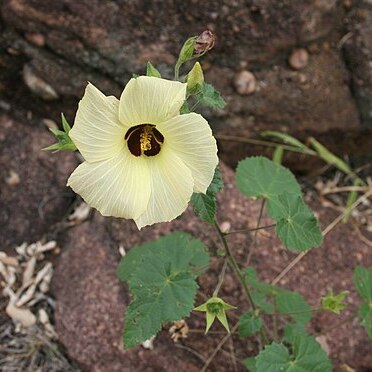Flowers 5–6 cm. in diam., yellow with maroon or dark red centres, solitary in the axils of the upper leaves and in corymbose terminal or lateral racemes or panicles; peduncle up to 6 cm. long, hairy like the stems, articulated near the apex.
Herb, 1.0-1.5 m high, with coarse tomentum intermixed with yellowish irritant hairs. Epicalyx of 7-10 bracts, threadlike, not wider than 0.5 mm. Flowers yellow with maroon or dark red centres.
Epicalyx of 7–10 bracts; bracts 1 ·5–3·5 mm. long, filiform, usually extending less than halfway to the sinuses formed by the calyx-lobes.
Erect herb up to c. 15 m. tall; stems tomentose or pubescent and rough with yellow stellate-setose or simple irritant hairs.
Petals up to 5 × 4 cm., obovate, stellate-pubescent outside where not overlapped, glabrous within.
Calyx up to c. 16 mm. long; lobes triangular, joined at the base for 7–8 mm.
Capsule up to 15 × 9 mm., ellipsoid, setose, with awns up to 3 mm. long.
Staminal tube 16 mm. long; free parts of filaments 1–1·5 mm. long.
Seeds 2·5 × 2 mm., angular-subreniform, sparsely lepidote.
Style-branches 3–4 mm. long.

